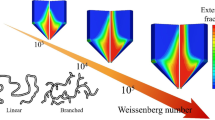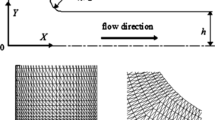Abstract
The flow of a bi-disperse polymer melt through a hyperbolic contraction is simulated using the recently proposed Rolie-Double-Poly constitutive model (Boudara et al., 2019). This simplified tube model takes account of the nonlinear coupling between the dynamics of the long and short-chains in a bi-disperse blend, in particular it reproduces the enhancement of the stretch relaxation time that arises from the coupling between constraint release and chain retraction. Flow calculations are performed by implementing both the Rolie-Double-Poly and multimode Rolie-Poly models in OpenFOAM using the RheolTool library. While both models predict very similar flow patterns, the enhanced stretch relaxation of the Rolie-Double-Pol models results in an increase in the molecular stretch of the long chain component in the pure extensional flow along the centre-line of the contraction, but a decrease in the stretch in shear-flow near the channel walls.
Similar content being viewed by others
References
Auhl, D., J. Ramrez, A.E. Likhtman, P. Chambon, and C. Ferny-hough, 2008, Linear and nonlinear shear flow behavior of monodisperse polyisoprene melts with a large range of molecular weights, J. Rheol. 52, 801–835.
Boudara, V.A.H., J.D. Peterson, L.G. Leal, and D.J. Read, 2019, Nonlinear rheology of polydisperse blends of entangled linear polymers: Rolie-Double-Poly models, J. Rheol. 63, 71–91.
Collier, J.R., O. Romansoschi, and S. Petrovan, 1998, Elonga-tional rheology of polymer melts and solutions, J. Appl. Polym. Set69, 2357–2367.
Collis, M.W., A.K. Lele, M.R. Mackley, R.S. Graham, D.J. Groves, A.E. Likhtman, T.M. Nicholson, O.G Harlen, T.C.B. McLeish, L.R. Hutchings, C M. Fernyhough, and R N. Young, 2005, Constriction flows of monodisperse linear entangled polymers: Multiscale modeling and flow visualization, J. Rheol. 49, 501–522.
de Gennes, P.G, 1971, Reptation of a polymer chain in the presence of fixed obstacles, J. Chem. Phys. 55, 572–579.
des Cloizeaux, J., 1988, Double reptation vs. simple reptation in polymer melts, Europhys. Lett. 5, 437–442.
Doi, M. and S.F. Edwards, 1986, The Theory of Polymer Dynamics, Oxford University Press Inc., Oxford.
Graham, R.S., A.E. Likhtman, T.C.B. McLeish, and S.T. Milner, 2003, Microscopic theory of linear, entangled polymer chains under rapid deformation including chain stretch and convective constraint release, J. Rheol. 47, 1171–1200.
James, D.F., G M. Chandler, and S.J. Armour, 1990, A converging channel rheometer for the measurement of extensional viscosity, J. Non-Newton. Fluid Mech. 35, 421–443.
Likhtman, A.E. and R.S. Graham, 2003, Simple constitutive equation for linear polymer melts derived from molecular theory: Rolie-Poly equation, J. Non-Newton. Fluid Mech. 114, 1–12.
Lord, T.D., L. Scelsi, D.G Hassell, M.R. Mackley, J. Embery, D. Auhl, O.G. Harlen, R. Tenchev, P.K. Jimack, and M.A. Walk-ley, 2010, The matching of 3D Rolie-Poly viscoelastic numerical simulations with experimental polymer melt flow within a slit and a cross-slot geometry, J. Rheol. 54, 355–373.
Pimenta, F. and M.A. Alves, 2017, Stabilization of an open-source finite-volume solver for viscoelastic fluid flows, J. Non-Newton. Fluid Mech. 239, 85–104.
Read, D.J., K. Jagannathan, S.K. Sukumaran, and D. Auhl, 2012, A full-chain constitutive model for bidisperse blends of linear polymers, J. Rheol. 56, 823–873.
Tenchev, R., T. Gough, O.G. Harlen, P.K. Jimack, D.H. Klein, and M.A. Walkley, 2011, Three dimensional finite element analysis of the flow of polymer melts, J. Non-Newton. Fluid Mech. 166, 307–320.
Weller, H.G., G. Tabor, H. Jasak, and C. Fureby, 1998, A tensorial approach to computational continuum mechanics using object-oriented techniques, Comput. Phys. 12, 620–631.
Acknowledgments
AA would like to acknowledge funding from the Ministry of Education Malaysia and the Universiti Sains Malaysia. OGH also acknowledges funding from EPSRC Grant Ref. EP/P005403/1.
We would like to thank Victor Boudara and Daniel Read for helpful insights and discussions on the Rolie-Double-Poly model.
Author information
Authors and Affiliations
Corresponding author
Additional information
Publisher's Note
Springer Nature remains neutral with regard to jurisdictional claims in published maps and institutional affiliations.
This paper is based on an invited lecture presented by the corresponding author at the 30th Anniversary Symposium of the Korean Society of Rheology (The 18th International Symposium on Applied Rheology (ISAR)), held on May 21-24, 2019, Seoul.
Rights and permissions
About this article
Cite this article
Azahar, A.A., Harlen, O.G. & Walkley, M.A. Modelling contraction flows of bi-disperse polymer blends using the Rolie-Poly and Rolie-Double-Poly equations. Korea-Aust. Rheol. J. 31, 203–209 (2019). https://doi.org/10.1007/s13367-019-0021-6
Received:
Revised:
Accepted:
Published:
Issue Date:
DOI: https://doi.org/10.1007/s13367-019-0021-6




